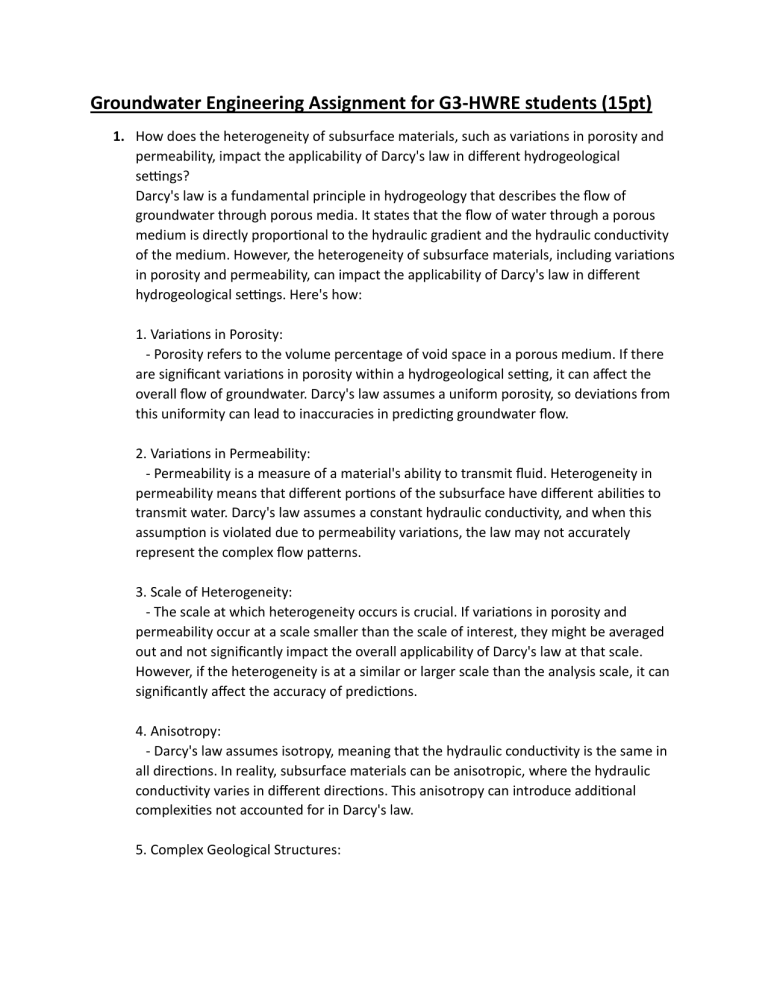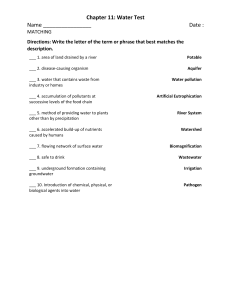
Groundwater Engineering Assignment for G3-HWRE students (15pt) 1. How does the heterogeneity of subsurface materials, such as variations in porosity and permeability, impact the applicability of Darcy's law in different hydrogeological settings? Darcy's law is a fundamental principle in hydrogeology that describes the flow of groundwater through porous media. It states that the flow of water through a porous medium is directly proportional to the hydraulic gradient and the hydraulic conductivity of the medium. However, the heterogeneity of subsurface materials, including variations in porosity and permeability, can impact the applicability of Darcy's law in different hydrogeological settings. Here's how: 1. Variations in Porosity: - Porosity refers to the volume percentage of void space in a porous medium. If there are significant variations in porosity within a hydrogeological setting, it can affect the overall flow of groundwater. Darcy's law assumes a uniform porosity, so deviations from this uniformity can lead to inaccuracies in predicting groundwater flow. 2. Variations in Permeability: - Permeability is a measure of a material's ability to transmit fluid. Heterogeneity in permeability means that different portions of the subsurface have different abilities to transmit water. Darcy's law assumes a constant hydraulic conductivity, and when this assumption is violated due to permeability variations, the law may not accurately represent the complex flow patterns. 3. Scale of Heterogeneity: - The scale at which heterogeneity occurs is crucial. If variations in porosity and permeability occur at a scale smaller than the scale of interest, they might be averaged out and not significantly impact the overall applicability of Darcy's law at that scale. However, if the heterogeneity is at a similar or larger scale than the analysis scale, it can significantly affect the accuracy of predictions. 4. Anisotropy: - Darcy's law assumes isotropy, meaning that the hydraulic conductivity is the same in all directions. In reality, subsurface materials can be anisotropic, where the hydraulic conductivity varies in different directions. This anisotropy can introduce additional complexities not accounted for in Darcy's law. 5. Complex Geological Structures: - Geological structures, such as faults, fractures, and layers, can create preferential pathways for groundwater flow. These structures may not be adequately represented by Darcy's law, which assumes a more homogeneous medium. In summary, while Darcy's law is a valuable tool in many hydrogeological applications, its applicability can be limited in settings with significant heterogeneity in subsurface materials. In such cases, more advanced models, such as numerical simulations that consider the spatial variability of properties, may be necessary to capture the complex flow patterns accurately. 2. How do human activities, such as groundwater pumping and land development, impact the integrity and functioning of aquifers, aquitards, aquicludes, and aquifuges in groundwater systems? And, also impact the balance of the hydrologic cycle and groundwater resources? Human activities, particularly groundwater pumping and land development, can have significant impacts on the integrity and functioning of aquifers, aquitards, aquicludes, and aquifuges in groundwater systems. Additionally, these activities can affect the balance of the hydrologic cycle and overall groundwater resources. Here's how: 1. Groundwater Pumping: Drawdown and Cone of Depression: Excessive pumping can lead to a lowering of the water table or potentiometric surface, causing a cone of depression in the water table. This can result in reduced groundwater levels and may lead to the drying up of wells and springs. Subsidence: Prolonged and intensive pumping can cause land subsidence, particularly in areas with compressible aquifer materials. This subsidence can damage infrastructure and reduce the capacity of aquifers to store water. Saltwater Intrusion: Over-pumping of freshwater can induce saltwater intrusion in coastal aquifers, where saline water from the ocean infiltrates into the freshwater aquifer. This can jeopardize the quality of the groundwater, making it unsuitable for many uses. 2. Land Development: Impervious Surfaces: Urbanization and land development often result in increased impervious surfaces such as roads and buildings. This reduces the amount of water that can infiltrate into the ground, leading to decreased recharge of aquifers. Altered Runoff Patterns: Changes in land use can alter natural runoff patterns. Increased runoff can lead to more rapid transport of pollutants, such as fertilizers and contaminants, into aquifers, affecting water quality. Aquifer Recharge: Urban development can alter natural recharge processes by covering large areas with impermeable surfaces, reducing the amount of water that can percolate into the ground to replenish aquifers. 3. Impact on Aquitards, Aquicludes, and Aquifuges: Compaction and Damage: Human activities, especially those involving construction and heavy machinery, can compact and damage aquitards llow permeability layers that hinder groundwater movement), aquicludes limpermeable layers that prevent the movement of groundwater), and aquifuges lnon-aquifer formations incapable of transmitting significant quantities of water). Contamination: Improper disposal of waste, industrial activities, and agricultural practices can lead to contamination of aquifers through the penetration of pollutants through aquitards. 4. Hydrologic Cycle and Groundwater Resources: Altered Recharge: Changes in land use, deforestation, and alterations to natural landscapes can impact the natural processes of infiltration and recharge, affecting the overall balance of the hydrologic cycle and reducing the replenishment of groundwater. Streamflow Depletion: Excessive groundwater pumping can deplete streamflow by reducing the contribution of groundwater to streams and rivers. This can negatively impact aquatic ecosystems and water availability downstream. Climate Change: Human-induced climate change can also influence the hydrologic cycle, leading to changes in precipitation patterns, evaporation rates, and overall water availability, which can further impact groundwater resources. In summary, human activities have the potential to alter the integrity, functioning, and sustainability of groundwater systems, with implications for water quantity and quality. Sustainable management practices, regulatory measures, and increased awareness are essential to mitigate these impacts and ensure the long-term viability of groundwater resources. 3. What are the differences between constant-rate, step-drawdown, and recovery tests, and when is each type of test appropriate? Constant-rate, step-drawdown, and recovery tests are different types of aquifer tests conducted to assess the hydraulic properties of aquifers. Each test provides specific information about the aquifer's characteristics under different conditions. Here are the key differences and when each type of test is appropriate: 1. Constant-Rate Test: Description: In a constant-rate test, a well is pumped at a constant rate, and water level measurements are taken over time. The drawdown lthe decrease in water level) is monitored during the pumping period. Purpose: Constant-rate tests are useful for estimating the aquifer's transmissivity, storativity, and hydraulic conductivity. The data collected during the test are used to analyze the aquifer's response to sustained pumping. Appropriateness: - Ideal for assessing the long-term behavior of an aquifer. - Well-suited for determining the transmissivity of the aquifer. 2. Step-Drawdown Test: Description: In a step-drawdown test, the pumping rate is changed in discrete steps, and drawdown is measured at each step. The well is pumped at a given rate for a specified time, then the rate is increased or decreased, and drawdown is measured again. Purpose: Step-drawdown tests are conducted to analyze the response of an aquifer to varying pumping rates. They provide information on how the aquifer's properties change with different rates of abstraction. Appropriateness: - Useful for assessing the influence of different pumping rates on the aquifer. - Provides insights into the well's capacity to sustain different pumping rates. 3. Recovery Test: Description: A recovery test involves stopping pumping after a constant-rate or step-drawdown test and observing how quickly the water level recovers. The rate of recovery provides information about the aquifer's storage properties. Purpose: Recovery tests are conducted to assess the storativity and specific yield of the aquifer. They provide information on how much water can be released from storage in the aquifer. Appropriateness: - Valuable for determining the storage characteristics of the aquifer. - Helps assess the time it takes for the water level to rebound after pumping stops. Appropriate Conditions: Constant-Rate Test: - When the objective is to understand the long-term behavior of the aquifer. - When the goal is to estimate transmissivity and hydraulic conductivity accurately. Step-Drawdown Test: - When there is interest in assessing the impact of varying pumping rates on the aquifer. - When evaluating well performance under different abstraction scenarios. Recovery Test: - After a constant-rate or step-drawdown test to assess storage properties. - When determining how quickly water levels recover after pumping ceases. Overall, the choice of aquifer test depends on the specific goals and characteristics of the aquifer being studied. It's common to conduct a combination of these tests to obtain a comprehensive understanding of the aquifer's hydraulic properties. 4. In area of 200ha, the water table declines by 3.5m if the porosity of an aquifer material is 30% and its specific retention is 15% determine the specific yield of an aquifer and change in ground water storage? 5. A constant-head test was conducted on a sample of soil 15cm long and 60cm2 in cross-sectional area. The quantity of water collected was 50cm3 in 20 seconds under a head difference of 24cm. calculate the hydraulic conductivity. if the porosity of the sand were 55%, calculate the average velocity and the seepage velocity. Estimate the hydraulic conductivity of a similar soil with a porosity of 35% from the results of this test. 6. A 10cm. Diameter well penetrates an 8m thick water bearing strata underlain and overlain by impermeable beds. The well was operated with a constant discharge rate of 100litres/min for 12 hours. The steady state draw downs were found to be 3 and 0.5 m at distance 10m and 50m respectively from the center of the well. Using Dupuit Theim equation, calculate the Transmissivity and hydraulic conductivity of the aquifer.



